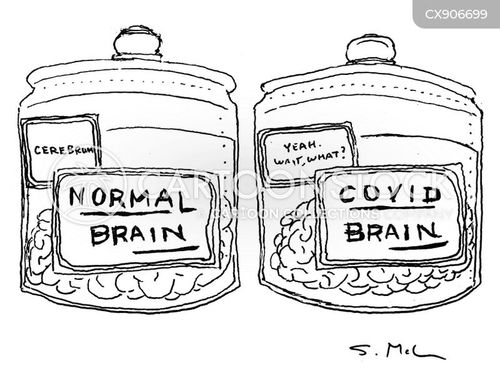
In fact, several methods to detect genetic material or proteins from the virus all turned up empty.

They could find no evidence in the brain tissue samples that SARS-CoV-2 had invaded the brain tissue. While those findings are certainly interesting, perhaps equally noteworthy is what Nath and colleagues didn’t see in those samples. The dark spots showed a different pattern, with leaky vessels and clots but no evidence of an immune reaction. This leakage appeared to trigger an immune reaction that included T cells from the blood and the brain’s scavenging microglia. A closer look at the bright spots showed that tiny blood vessels in those areas were thinner than normal and, in some cases, leaked blood proteins into the brain. They also showed dark spots, which indicate bleeding. Indeed, the MRI images revealed in both regions an unusual number of bright spots, a sign of inflammation. Based on earlier evidence, both areas are thought to be highly susceptible to COVID-19. The team focused on the brain’s olfactory bulb that controls our ability to smell and the brainstem, which regulates breathing and heart rate. They ranged in age from 5 to 73, and some had preexisting conditions, such as diabetes, obesity, and cardiovascular disease. The NIH team, led by Avindra Nath, used a high-powered magnetic resonance imaging (MRI) scanner (up to 10 times as sensitive as a typical MRI) to examine postmortem brain tissue from 19 patients. Their findings, published in the New England Journal of Medicine, suggest that COVID-19’s many neurological symptoms are likely explained by the body’s widespread inflammatory response to infection and associated blood vessel injury-not by infection of the brain tissue itself. In search of clues, researchers at NIH’s National Institute of Neurological Disorders and Stroke (NINDS) have now conducted the first in-depth examinations of human brain tissue samples from people who died after contracting COVID-19. The first of these symptoms might be the loss of smell and taste, while some people also may later battle headaches, debilitating fatigue, and trouble thinking clearly, sometimes referred to as “brain fog.” All of these symptoms have researchers wondering how exactly the coronavirus that causes COVID-19, SARS-CoV-2, affects the human brain. While primarily a respiratory disease, COVID-19 can also lead to neurological problems. Credit: National Institute of Neurological Disorders and Stroke, NIH

Arrows point to light and dark spots indicative of blood vessel damage with no signs of infection by the coronavirus that causes COVID-19.

Francis Collins Caption: Magnetic resonance microscopy showing lower part of a COVID-19 patient’s brain stem postmortem. Taking a Closer Look at COVID-19’s Effects on the Brain


 0 kommentar(er)
0 kommentar(er)
